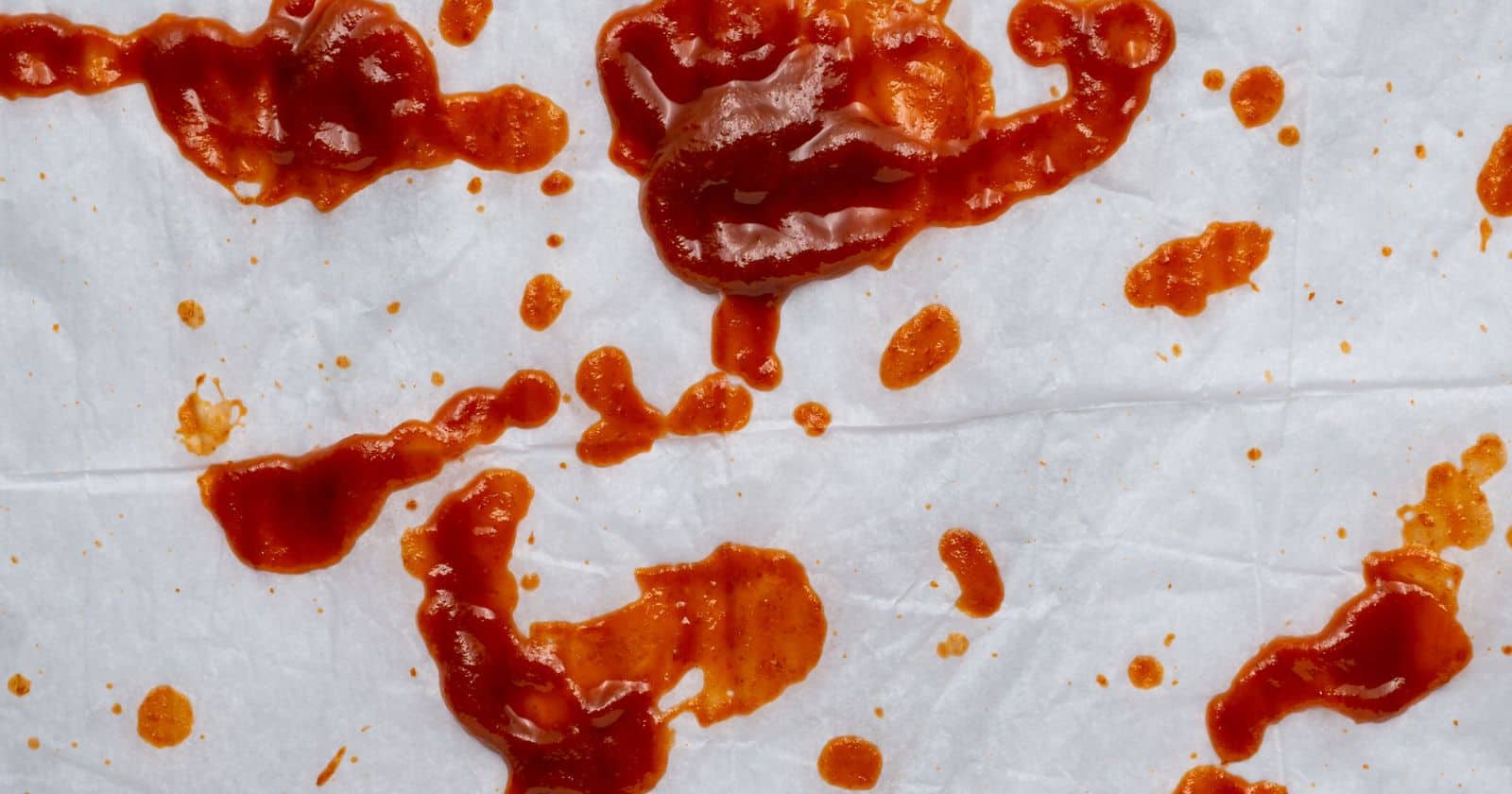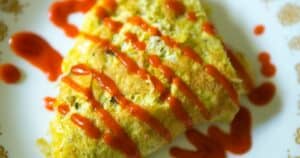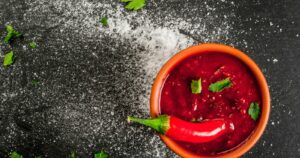That sinking feeling when you notice a big splotch of dried hot sauce on your favorite shirt. No matter how careful you are, spicy accidents happen, staining clothes with that telltale orange-red badge of flavorful pride.
While fresh wet stains can often be quickly rinsed away, dried and set-in hot sauce spots present more of a challenge. The good news is, with the right techniques, you can banish those dried stains and recover your wardrobe. It just takes a little patience and persistence.
In this post, I’ll share several methods you can try to remove stubborn dried hot sauce stains from clothes and other fabrics. From scraping to blotting to alternating stain-fighting ingredients, you’ll have a whole arsenal of strategies to break down those sticky, spicy residues.
With some work, your favorite salsa shirt or buffalo wing pants can come out looking fresh again. Read on to learn how to win the battle against dried hot sauce stains!
Act Fast for Best Results
For the best chance of removing dried hot sauce stains, take action as soon as possible. The longer the stain sits, the more it can set into fibers.
- As soon as you notice the stain, use a spoon, dull knife or credit card to scrape off as much of the dried sauce as you can.
- Flake off any thick, crusty areas. Remove all loose particles clinging to the fabric’s surface.
- This helps eliminate a good amount of staining material before it bonds tightly to the fibers.
- Even for older stains, scrape off any excess you can before using other stain removal methods.
Blot Repeatedly With Rubbing Alcohol
One of the most effective ways to tackle dried hot sauce stains is blotting with rubbing alcohol. The alcohol helps dissolve and draw out the staining compounds.
Follow these steps:
- Start with the stained area face down on layers of clean rags or paper towels.
- Use an eye dropper to apply rubbing alcohol directly to the back of the stain. Or soak a cotton ball or cloth with the alcohol and blot it on.
- As it absorbs into the fabric, place fresh paper towels or rags underneath and blot again. Apply more alcohol and keep blotting.
- Turn fabric over and dab rubbing alcohol directly on the stained area as well. Blot repeatedly with clean cloths or paper towels.
- Continue blotting and reapplying the alcohol until you’ve removed as much of the stain as possible.
- Once done, allow the area to fully air dry. The alcohol will evaporate quickly.
- Launder as usual once fully dry.
Rinse Well With Cold Water
Rinsing under cold running water can help flush away staining particles loosened by other pre-treatments.
- Hold the stained area under steadily running cold water.
- Let the water run over the back of the fabric, rinsing from behind to avoid spreading the stain outward.
- Rub very gently between your fingers to help dislodge stain residue from fibers without grinding it in.
- Keep rinsing until the water runs clear.
Pretreat With Laundry Detergent
Heavy duty liquid laundry detergents can help break down staining compounds. Apply directly and let sit before washing.
- Select an enzyme-based detergent made for pretreatment of stains. Liquid works better than powdered.
- Apply a small amount directly to the stain. Use a clean toothbrush or fingers to work it in very gently.
- Don’t vigorously rub, which can further set the stain. Just lightly coat the fibers.
- Let the detergent sit for 15-30 minutes to penetrate and loosen the stain.
- Rinse very thoroughly before washing. Detergent residues can cause buildup.
Alternate With Vinegar
As anyone who’s experienced hot sauce stains knows, vinegar is a great natural stain fighter. The mild acid helps dissolve and lift staining particles.
- Fill a spray bottle with distilled white vinegar. Or soak a clean sponge or cloth with vinegar.
- Lightly mist the stain with vinegar or dab vinegar directly on with your cloth. Avoid vigorously rubbing.
- Let the vinegar sit 5-10 minutes to work.
- Rinse thoroughly with cold water.
You can alternate using detergent and vinegar as stain-fighting weapons. Apply vinegar first to help loosen and lift the stain, follow with detergent to further break it down.
Launder as Usual Once Stain is Removed
Once you’ve pretreated a dried hot sauce stain using these steps, let the garment fully air dry. The alcohol and vinegar should evaporate completely.
Then launder as usual with your regular detergent, checking that the stain is fully removed. Avoid drying stained items in the dryer until stains are gone or they can set permanently.
With repeated stain-fighting sessions, you should be able to eliminate those pesky dried hot sauce spots. Be patient and keep at it!
Tips for Avoiding Hot Sauce Stains
While removing dried stains takes work, avoiding them in the first place is easier. Here are some tips:
- Wear an apron or old shirt when cooking with hot sauce. Better to stain what’s easily washed.
- Immediately rinse hot sauce splatters on clothes with cold water. Hot water can set some stains.
- Keep stain remover spray or wipes handy during meals. Pre-treat spots right after they happen.
- Apply salt, talcum powder or cornstarch to absorb wet stains quickly. Let sit before rinsing.
- Check clothes for stains before tossing in the laundry. Pretreat spots before washing.
- Read clothing labels and don’t wash items in water hotter than recommended. Heat can set stains.
How to Remove Hot Sauce Stains from Other Surfaces
Hot sauce isn’t just a laundry nightmare. It can also stain furniture, carpets, walls and other surfaces. Here are some tips for tackling household hot sauce spots:
Carpet Stains
- Blot excess sauce immediately with a clean cloth. Don’t rub, which forces it deeper into carpet fibers.
- Lightly spray white vinegar over the stain. Let sit 5-10 minutes.
- Blot lifted stain residue with more vinegar on a clean cloth.
- Mix dish soap with warm water and apply to stain. Gently blot with a sponge. Rinse thoroughly.
Furniture Upholstery
- Use a dull knife to scrape off any thick, crusted sauce. Remove all loose particles.
- Mix equal parts vinegar and water. Dampen a clean cloth and gently blot the stain.
- If needed, use an enzyme-based upholstery cleaner following label directions.
- Rinse and blot with just water when done. Let fully dry.
Tile, Vinyl or Laminate Flooring
- Wipe up excess sauce immediately with paper towels. Rinse any residue with water.
- Mix dish soap with warm water. Use a sponge or mop to wash the floor.
- Rinse thoroughly with clean water. Repeat if needed.
- Avoid abrasive scrubbers or cleaners, which can scratch flooring.
Walls and Painted Surfaces
- Use a plastic scraper or putty knife to remove thick, dried sauce.
- Make a paste of baking soda and water. Gently rub onto the stain and let sit briefly.
- Wipe clean with a soft, damp cloth. Repeat if needed.
- Avoid excessive moisture, harsh scrubbing or cleaners, which can damage paint and drywall.
With the right technique for each surface, even dried hot sauce splatters around the house don’t stand a chance. A little persistence pays off.
How to Get Hot Sauce Out of Hair, Skin and Eyes
Spicy accidents happen! If you get hot sauce on more sensitive areas of your body, act fast:
Hair: Shampoo several times with cool water. Avoid hot water, which opens pores and lets capsaicin absorb. Rinse with equal parts vinegar and water.
Skin: Wash with soap and cool water immediately. Apply whole milk to soothe burning. Avoid irritation by wearing gloves when handling peppers.
Eyes: Flush eyes with cool water for 10-15 minutes. Remove contacts if possible. Seek medical help if burning persists over 30 minutes. Don’t rub eyes, which worsens irritation.
The key is always rinsing sensitive skin and membranes with lots of cool, clean water to dilute and flush away hot sauce irritation. Treat the
Common Hot Sauce Stain Mistakes to Avoid
When attempting to remove dried hot sauce stains, some well-intentioned methods can actually backfire and make the problem worse. Here are some mistakes to steer clear of:
- Don’t use hot water, which can set in stains permanently. Always use cold or lukewarm water.
- Don’t vigorously scrub or rub stains, which can grind residue deeper into fibers.
- Don’t apply bleach without first consulting clothing care labels. It can cause color loss.
- Don’t dry stained items in a hot dryer, which can permanently set stains.
- Don’t wash with harsh cleaners not formulated for laundry use. Stick to recommended products.
- Don’t overload your washing machine, which dilutes detergents and prevents effective stain removal.
- Don’t ignore care labels. Follow garment washing instructions to avoid damage.
Patience and gentle persistence are key when tackling dried hot sauce stains. With the right techniques and care, you can enjoy your favorite spicy foods without ruining clothes. Just keep plenty of stain fighters at hand, act quickly when accidents happen, and review these tips next time you face hot sauce spots.
FAQs About Removing Dried Hot Sauce Stains
1. What’s the best stain remover for dried hot sauce stains?
Rubbing alcohol is one of the most effective products for dried hot sauce stains. The alcohol helps break down and dissolve staining compounds. Just be sure to rinse and launder after blotting.
2. How do I get dried hot sauce out of white clothes or fabrics?
Start by scraping off any excess dried sauce. Rinse with cold water then soak in a diluted vinegar solution. Rub gently with baking soda. Launder with bleach-safe detergent. Don’t dry until stain is fully removed.
3. Is it possible to get old, set-in hot sauce stains out?
Yes, even older stains can be removed with persistence. Scrape off any crusted sauce then pretreat with alcohol, detergent and vinegar. It may take several rounds of treatment but set-in stains can come out.
4. What temperature water should be used when rinsing hot sauce stains?
Always use cold or lukewarm water under around 80°F. Hot water can permanently set in stains. Cold water works best for rinsing away staining residues.
5. How do I avoid hot sauce stains on clothes in the future?
Wear an apron when cooking with hot sauce. Rinse splatters immediately with cold water. Keep pretreat sprays or wipes handy to use right away on spots. Check clothes for stains before washing and drying.
Be patient, gentle, and persistent, testing removal methods in inconspicuous spots first. With the right techniques, even stubborn dried hot sauce stains can eventually come out.





